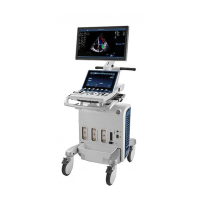Image Optimization
5-28 Vivid S70 / S60 – User Manual
BC092760-1EN
01
Using Tissue Tracking
1. From TVI Mode, press Tissue Tracking.
2. Adjust Tracking start close to the R-peak.
3. Adjust Tracking end to end systole.
4. Use the trackball to position the ROI frame over the area to
be examined.
5. Press Select. The instruction Size should be highlighted in
the trackball status bar.
NOTE: If the trackball control Pointer is selected, press Trackball to
be able to select between Position and Size controls.
6. Use the trackball to adjust the dimension of the ROI.
Optimizing Tissue Tracking
• To reduce quantification noise (variance), the Nyquist limit
should be as low as possible, without creating aliasing. To
reduce the Nyquist limit, reduce the scale while in TVI.
• To check for aliasing, freeze the loop and apply velocity
trace (Press Freeze and Q-Analysis), see also
‘Quantitative Analysis’ on page 9-1).
• The main use of Tissue Tracking is to map positive systolic
displacements. This means that Tracking start and
Tracking end controls should be adjusted to pick out the
systolic phase of the cardiac cycle. Adjust Tracking start
close to the R-Peak. Adjust Tracking end to end systole,
typically near the T-wave.
NOTE: Tissue Tracking on TEE acquisitions displays negative
displacements. Make sure Invert is selected to display
positive displacements.
• Negative displacement can be mapped by pressing Invert.
Tracking start and Tracking end must then be adjusted to
pick out the diastolic phase of the cardiac cycle.
• The maximum displacement that is color-coded can be
adjusted using Tracking scale. If set too low, most of the
wall will show the color indicating maximum displacement. If
set too high, the maximum displacement color is never
reached.
• Tissue Tracking provides velocity information only in the
beam direction. The apical view typically provides the best
window since the beams are then approximately aligned to
the longitudinal direction of the myocardium (except near
the apex).

